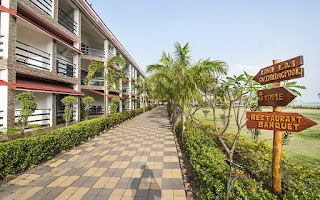Being bogged down in lock down can be agonizing. With the lock down phase giving way to unlock phases, the tired soul searches for an opportunity to escape from the four walls of frustration. The balancing between the possibility of an infection from the virus that razes the globe and venturing into a spot that gives succor to the weary mind is like walking on a razor’s edge. The options were varied and opinions multiple. Finally, Sonar Bangla Kolaghat stood out till the end for a day-out in the lap of nature with all the creature comfort needed for an opulent outing.
From Kolkata the resort is hardly a two hours drive and is within 60 KM from Vidyasagar Setu. The drive up to Kolaghat on NH6 is satisfying but one has to be cautious. Just before embarking the Kolaghat bridge, there is an inconspicuous diversion which can be missed by a casual driver. The miss can cost you time and some extra fuel as the crossings are far off. The diversion ends up on a bumpy track and the all the hotel heading cars dance their ways keeping the sprawling Roopnarayan to their right. The road is possibly upon a dyke, elevated up to a few meters above the banks to protect the village for the high tides of the monsoon or the topical cyclones.
The hotel sits on the northern bank of the river in the village of Orphooly, at Bagnan, Howrah. It actually overlooks Kolaghat on the opposite bank. It has 110 rooms all sumptuously furnished and each facing the river. Between the rooms’ balconies and the river are lush green lawns, a full-size swimming pool and a strand along the bank. The strand is a walkers’ delight. One can also enjoy cycling in and around the property on cycles provided by the hotel. Kids can enjoy swings or trampoline placed on the lawn. For the youngsters there are indoor games like Table Tennis and carom. Otherwise they can try their hand in badminton. Of course there are regular outdoor games like football and cricket to boot. Had there been a gym, the sports facilities would have been more or less complete.
There are two halls of 6000 and 12000 square feet for banquet or conference. The restaurant is well decorated but without a bar. Food is at standard and served with deference by the waiters. The halls and the restaurant face the river and one can enjoy the expanse from every corners. Breakfast is complementary but not for the ones taking a Day-out. For them the hotel offers 20% discount and 4 guests can book a single double bedded room. The check in usually is at 1200 hrs but can be preponed on request by a couple of hours for the day out guests, if rooms are available.
A temple of lord Shiva stands inside the gate for those with a spiritual bend of mind. But here in this land of luxury, the lord of renunciation is a tad bit lonely. Only a few boarders pay their reverence by the customary pranam while passing by. Even I did the same. Somewhere from His holy abode the Lord must have pardoned my hasty salute.
At Sonar Bangla one can see a confluence of diverse cultures. The nouveau riche and the elegant urbanite walk cheek by jowl and enjoy the ambiance in their own way. While the suave aristocrats stroll the strand, exuberant youths or even flabby upstarts dive in the pool oblivious of their raucous they sometimes create much to the consternation of the aged. But all these are well accepted as each individual has the liberty to enjoy their vacation in their own way. While returning one can visit the famous novelist, Sarat Chandra Chattopadhyay's house at Deulti, 5 Kms away.
Hotel Sonar Bangla, Kolaghat can be a whiff of fresh air from the jostle of the city. Its luxurious ambiance doesn’t dig a hole in your pocket. It’s a perfect location for a short getaway for the city dwellers who doesn’t cringe to spend a few extra bucks to escape from the clamour of the city’s din.
For details visit : https://www.hotelsonarbangla.com/kolaghat.php
+91-9051266660
+91-9051266260
kolaghat@hotelsonarbangla.com























